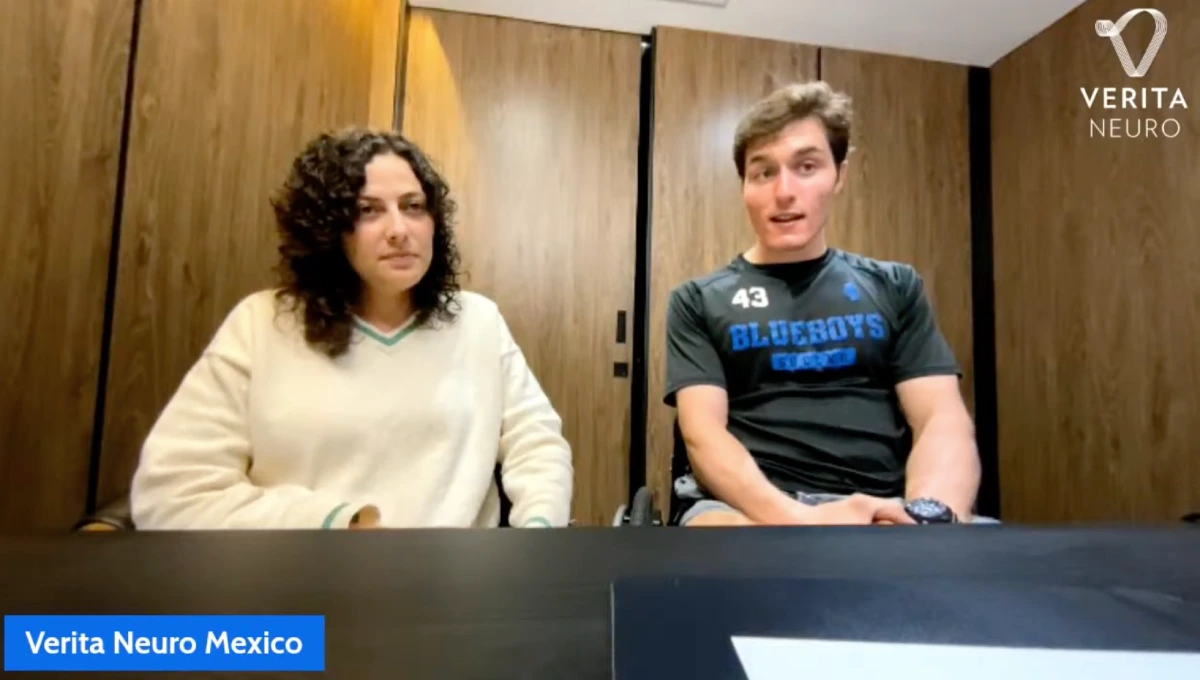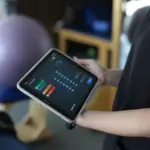In a recent YouTube Live and Facebook Live Q&A session, Attending Physician Dr. Paulina Marin was joined by Shane Callahan, a paraplegic T5 incomplete spinal cord injury patient from Chicago, USA. Shane and Paulina discuss the Epidural Stimulation and Stem Cell treatment Shane received at our hospital in Guadalajara, Mexico, and answer questions from the live audience.
A Conversation with Dr. Paulina Marin and Patient, Shane Callahan
Please introduce yourself and tell us about your injury.
Shane: My name is Shane Callahan. I’m from the United States and I have a T5 incomplete spinal cord injury. I was injured in a car accident on October 7th 2023. Before arriving at Verita Neuro, I had limited sensation in my abdomen and legs. Limited movement in my hips and glutes and only a tiny bit of movement in my toes. I had full function in my hands and my arms.
What treatment did you receive before arriving at Verita Neuro?
Shane: I was at Shirley Ryan Ability Lab in Chicago for two months and then I went home. I’ve been going to physical therapy at Next Steps in Chicago, trying to recover ever since. They are awesome but my recovery has been slow. With them I’ve been using a device called ARX. It’s from a company called Onward in Switzerland. It’s an external spinal cord stimulator and we pair that with activities like walking and standing and crawling. I came to Verita Neuro to work with the surgically implanted Epidural Stimulator which feels a lot different and I think it helps more.
What were some of the biggest challenges you faced early on?
Shane: Some of the biggest challenges were relearning how to do everyday things like getting dressed. Daily tasks like using the bathroom, showering. Then, learning how to maneuver in a wheelchair.
Shortly after my injury I developed heterotopic ossification in both my hips. This meant I had an abnormal amount of bone growth in both my hips and it really limited and restricted the movement and flexion of my hips. So it required surgery in both hips and that really slowed down my progress.
How did you first hear about Verita Neuro’s treatment? What made you decide to try it?
Shane: I first heard about Verita Neuro doing some research looking for alternative treatment options. At this point I’ve pretty much tried everything and it just seemed like a good option to try.
What treatment has Shane received for his T5 incomplete spinal cord injury at Verita Neuro?
Dr. Paulina: When Shane first arrived at Verita Neuro, to our hospital in Guadalajara, Mexico, the first thing we did was blood tests, an electrocardiogram (EKG) test, and other kinds of tests to see if he was ready for the surgery. Then he underwent an Epidural Stimulation surgery, which is a neurosurgery where an electrode is implanted that helps to improve the signal that passes from your brain, through your spine, to your legs and allows you to make voluntary movements, like contracting the quadriceps in order to stand, or even to take steps. Shane received one lumbar Epidural Stimulator. Following the surgery, we were able to administer Epidural Stimulation treatment, which helped him to regain some movements below the level of the injury. Like voluntary movements in his legs, which he couldn’t perform after the injury.
What is a typical day like at Verita Neuro?
Shane: My typical day here starts with physical therapy at 9am with the mapping therapist. So that’s using the Epidural Stimulator and using it with exercises and activities from 9am to 11am. Then I have a break for 1 hour and then I have a physical therapy session from 12pm to 1pm, then another break and then another mapping session from 2pm to 4pm.
What were the expectations for Shane’s spinal cord injury treatments?
Shane: I didn’t have any expectations. I set the bar pretty low, I just wanted to come here and try my best during all the physical therapy sessions and to see what effect the Stimulator, the physical therapy and the Stem Cells would have in my recovery.
Dr. Paulina: Shane was in pretty good shape when he arrived and that helps a lot. Patients who have completed a lot of physical therapy before coming to Verita Neuro, will see better results because they are more prepared to undergo a lot of hours of physical therapy and mapping. So the success of the treatment was hugely thanks to Shane and all the work he had put in to prepare. It’s also important to know that our treatments are not a cure for spinal cord injury, but we help Shane and other patients to improve their quality of life, to activate and flex their muscles, improve their muscle tone and even to stand or take steps with assistance.
How soon after the surgery did you start seeing improvements or changes?
Shane: There have been minor improvements from using the Stimulator with certain activities like standing and crawling and core work. Things have improved where it’s easier to stand up, it’s easier to crawl, it’s easier to do certain movements and exercises that were difficult for me before.
I’m not able to stand on my own. I need help from a physical therapist to lock out my knees but the stimulator makes it easier for me to lock out my knees on my own and to control my pelvis and hips. I have more balance.
Were there any moments during the treatment that surprised you either physically or emotionally?
Shane: Repeating movements over and over again with the stimulator and then seeing them progressively get easier and better. So things like crawling have really improved. Even when the stimulator is not on it’s gotten better. So that has been surprising. Standing feels better and stronger.
How has your mindset changed from the early days of injury to where you are now?
Shane: I think early on in my injury, the focus from the physical therapist was more about comfort and acceptance, rather than working to recover. So it’s been a really good shift in my mindset to actively try to recover and regain sensation and movement and body functions that I used to have. That’s been a major shift.
Questions from the Live Audience and other Frequently Asked Questions about Epidural Stimulation treatment at Verita Neuro
Do you have any discomfort or side effects from the treatment?
Shane: No discomfort, no side effects. I will say when I first received the Stem Cell treatment, because it’s an injection in the Intrathecal space, I did have a headache later that day but it went away after a few hours.
Originally, I did feel tired. The stimulator is intense because it activates muscles that haven’t been activated in a while. So even though I may not physically feel that my legs and my muscles are tired, it uses a lot of energy.
Do you feel the Epidural Stimulator or its battery inside your body? Do you experience any discomfort or pain, following the implantation?
Shane: No, I don’t feel any pain below my level of injury. So I don’t feel it and it doesn’t hurt at all. I can feel when the stimulator is turned on and there’s no discomfort or anything.
Is the Epidural Stimulator permanent or can it be removed once you start walking?
Dr. Paulina: Okay, so this is a really important question because, as I mentioned before, this is not a cure. We have patients who are eventually able to take steps with a walker, or with help. But the first improvement that you’re going to see is not walking. But, no it is not permanent either and yes, it can be removed. The Epidural Stimulator also has a battery which has eight to ten years of life and after that we can change the batteries without having to perform the full surgery again.
What is the potential outcome that Shane can achieve if he continues physical therapy?
Dr. Paulina: Shane already came to Verita Neuro with a good level of trunk control but this has improved since his treatment and he can continue to train and improve. We recommend at least one year of training using the stimulator five times per week. If he continues with more training I think he would eventually be able to make steps with a walker. I think he can achieve that. Of course, if he achieves more I will be glad but that would be the most common expectation for a patient with his condition to achieve.
We are also expecting improvements in his bowel and bladder control. Stem Cell treatment in particular can really help with bowel and bladder function. Shane already has sacral sensitivity to begin with but I expect it will continue to improve. Right now he’s using an intermittent catheter and he has a bowel program which works great for him, but it could improve over the coming months.
How long do you need to stay at Verita Neuro following treatment?
Dr. Paulina: Shane had a single Epidural Stimulator implanted at the lumbar level so he stays for 35 days. Some patients with injuries at the cervical spine level or higher need two Stimulators, which requires 50 days of treatment.
First, Shane was in the hospital for the Epidural Stimulation surgery and he stayed there for 10 days, to prevent infections through the use of IV and antibiotics. We started with mapping 48 hours after the surgery, while he was still in the hospital.
Mapping is the process used to program the stimulator to make the muscles contract, in order to make all the other movements like standing, stepping, trunk control and everything.
For those 35 days, he completes four or five hours of physical therapy every day. When we discharge Shane, we send him home with booklets, videos, and all the information he needs to keep working with his local physical therapists, using his new internal Epidural Stimulator. The surgery and treatment he has had at Verita Neuro, here in Mexico, will help to improve the program for him back at home, and to see more improvements.
Can Epidural Stimulation treatment help with incontinence and sexual dysfunction?
Dr. Paulina: The Epidural Stimulation treatment is designed to help improve motor function and movement. It’s not used to improve sexual function, or other automatic bodily functions. For this goal, we would talk more about Stem Cell treatment than Epidural Stimulation treatment.
Is it possible to get in touch with someone who is already a user for an Epidural Stimulator?
Dr. Paulina: Yes, we can ask some of the patients. Of course, we cannot give you the phone number but we can organise for you to talk to some existing patients.
What do you want to say to others who are newly injured and maybe feeling hopeless?
Shane: You know, I’m not a very inspirational person but to anyone who’s been injured, I would say don’t lose hope. There’s always hope. Just try everything. Work every day. Think about moving, think about feeling and just don’t give up. That’s probably the only advice I could give.
Are there any lifestyle restrictions after the Epidural Stimulation treatment?
Dr. Paulina: There is no restriction. You can use it in a pool, you can shower, you can do anything. There is also a mode that is compatible with MRI scans.
How soon after the surgery do you notice changes?
Shane: Right away. Once the stimulator was on it really worked to contract muscles that haven’t contracted since my injury. So muscles like my quadriceps, hamstrings, glutes, abdomen and lower back. So that was right away once they turned the stimulator on, those muscles that they were targeting were activated.
Can Epidural Stimulation treatment work on old injuries?
Dr. Paulina: Yes, it can. For old injuries, we evaluate the case, the same as we would for new injuries. We need an MRI to see if you are a candidate for a stimulator. Even if you have an old injury you may have some signal passing through the spine. If you have spasms or neuropathic pain, clinically that means that you have some signal passing through. Epidural Stimulation is used to improve the signal that is already passing through. So it works the same for old and new injuries.
Are Stem Cells always part of the treatment?
Dr. Paulina: Regularly, they are part of the treatment. Most of the patients receive Stem Cells and also the Epidural Stimulator, but if your injury is more than 10 or 15 years old, maybe we don’t try the Stem Cells because this is more effective for patients with injuries that are less than five years old. In saying that, I do have patients with injuries more than 10 years old who received Stem Cell treatment and it helped to improve bowel and bladder control. But yes, it’s usually part of the treatment.
Does Epidural Stimulation treatment really work for a complete spinal cord injury?
Dr. Paulina: Yes, but not all patients are candidates, whether they have complete or incomplete injuries. So we need to evaluate your case. You need an MRI or a CT scan to evaluate your injury and see whether you are a candidate. Often, patients with complete spinal cord injuries are suitable candidates for the Epidural Stimulation surgery and Stem Cell treatments. Also, sometimes patients think that they have a complete spinal cord injury but we find out during the assessment that the injury is, in fact, incomplete. But, regardless, we can work with both kinds of injuries.
Can someone with an ASIA A test result be eligible for Epidural Stimulation treatment?
Dr. Paulina: An ASIA A result indicates a complete injury but it doesn’t matter. We can still evaluate you. We need you to send us the MRI and after that we will do a consultation and we will see how the patient is clinically and if they are a candidate for Epidural Stimulator treatment or other treatments. We don’t only offer Epidural Stimulation for every patient, we also work with Stem Cell treatment and physical therapy. We offer a lot of different treatments that aren’t available in the United States and we approach treatment differently.
Can a C5-C7 tetraplegic patient apply?
Dr. Paulina: Yes, actually the most common injuries that we treat are C5-C6. So, yes, you can apply for all of our treatments, including Epidural Stimulation.
What’s your end goal with this stimulator? Do you ever see the technology improving?
Dr. Paulina: Yes, we think that the technology is going to improve. It’s been improving throughout the years. We don’t know if we may eventually be able to cure spinal cord injuries, but right now it’s the most innovative technology that we have and it continues to improve.
The above is not a verbatim transcript of Shane’s live interview. Some comments have been altered or rearranged to improve the reading flow. You can watch the full live show on our YouTube channel.





